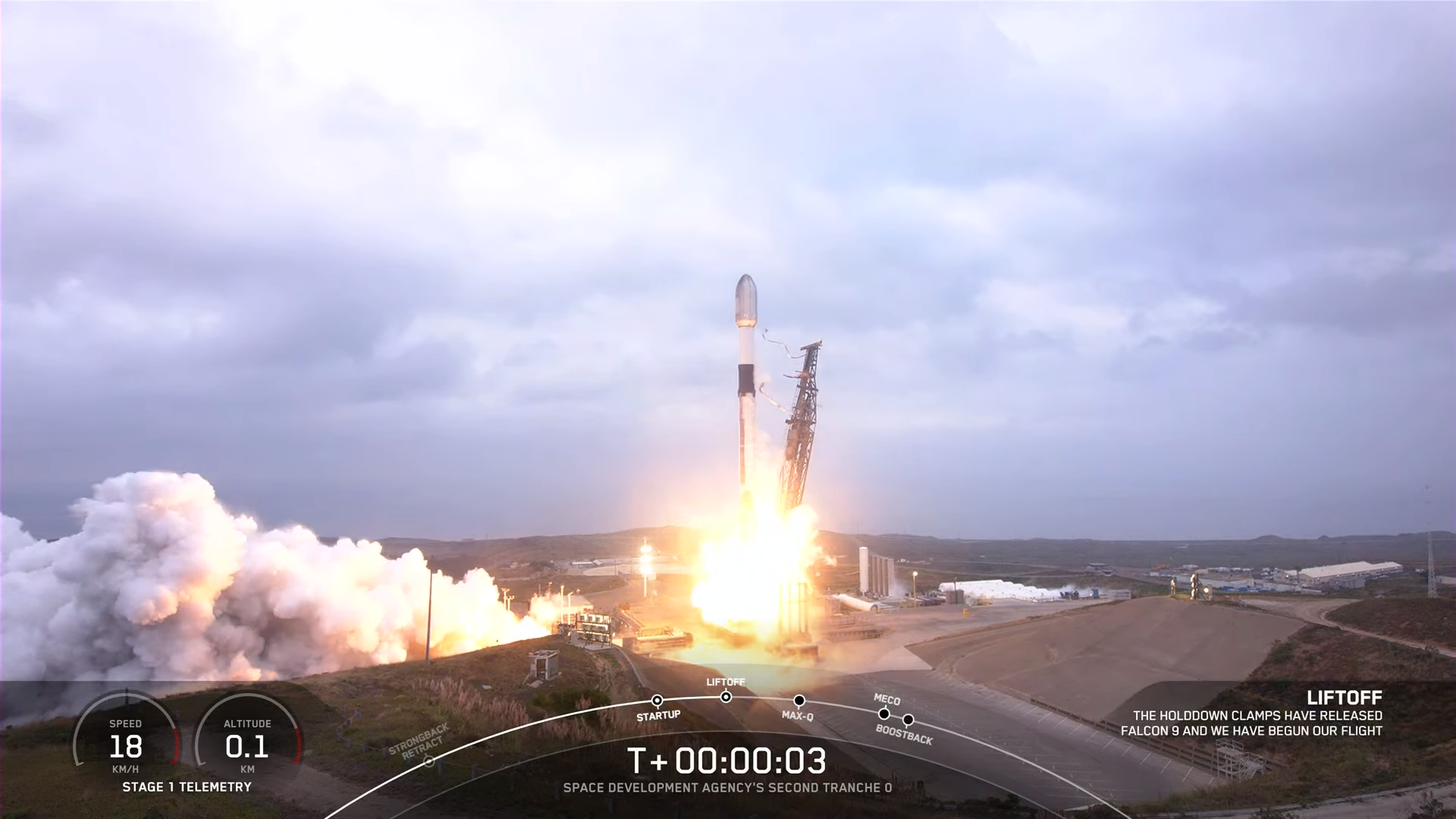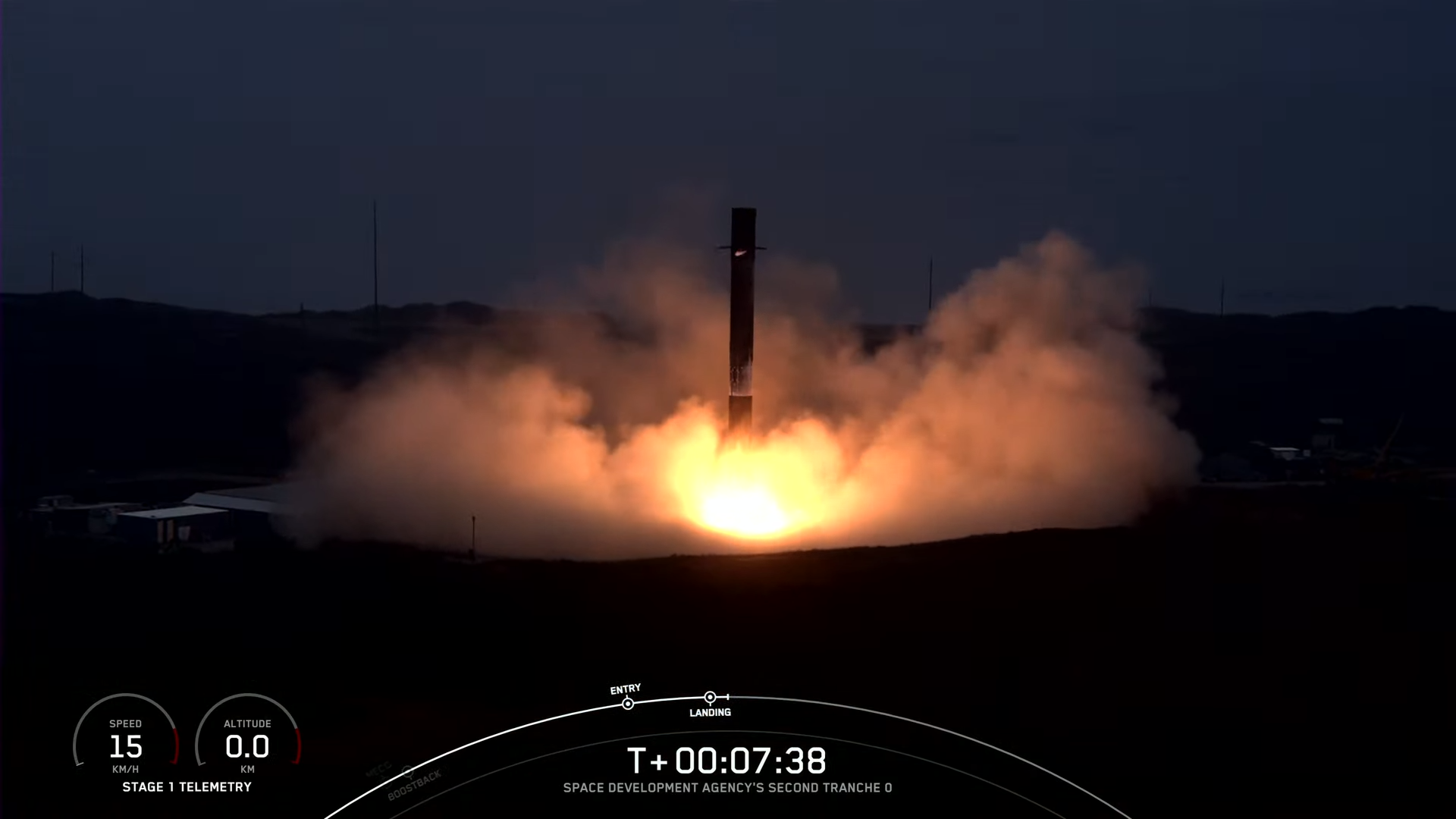SpaceX launched an advanced new set of military satellites into orbit for the U.S. Space Force on Saturday (Sept. 2) after a two-day delay and tied its own flight rate record at the same time.
A Falcon 9 rocket topped with 13 spacecraft for the Space Force's Space Development Agency (SDA) soared into the foggy morning sky above California's Vandenberg Space Force Base Saturday at 10:26 a.m. EDT (1426 GMT; 7:26 a.m. local California time), with its first stage booster returning to Vandenberg to stick its landing. It was the 13th flight for the rocket booster.
"With this launch, this marks SpaceX's 61st launch of 2023, matching last year's annual record with still four months to go before the end of this year," SpaceX avionics reliability engineer Zachary Luppen said during live commentary.
SpaceX initially attempted to launch the Tranche 0 mission on Aug. 31, but postponed due to an unexpected response from one of the nine engines on the Falcon 9 first stage, Luppen said. A second attempt on Sept. 1 was also called off about 12 minutes before liftoff due to a valve issue in ground equipment, he added.
Related: 8 ways SpaceX has transformed spaceflight

Saturday's launch marked SpaceX's second in support of the Proliferated Warfighter Space Architecture (PWSA), "a new layered network of satellites in low Earth orbit and supporting elements that will provide global military communication and missile warning, indication and tracking capabilities," SpaceX wrote in a description of the mission.
The first PWSA mission occurred in early April, when a Falcon 9 lofted 10 satellites from Vandenberg.
Get the Space.com Newsletter
Breaking space news, the latest updates on rocket launches, skywatching events and more!
These first two missions are dedicated to building out "Tranche 0," a demonstration constellation that will consist of 28 satellites, according to SpaceNews. Most of them are communications craft, but some are designed to detect missiles.
As its name suggests, Tranche 0 is just the beginning for the PWSA.
"Under the plan, the Space Force will have hundreds of small satellites, with new ones launched every few years to increase resilience and capabilities in orbit," Air and Space Forces Magazine wrote in late March.

If all goes according to plan, the Falcon 9's first stage will come back for a touchdown at Vandenberg about 7.5 minutes after launch today. It was 13th launch and landing for this particular booster and the 222nd overall recovery of an orbital-class rocket by SpaceX, Luppen said. It was also the company's 260th launch overall, he added.
It's unclear when the satellites will be deployed; SpaceX did not provide any information about that milestone. That's no surprise; details are often scarce on national security missions.
At the Space Development Agency's request, SpaceX did now show any live video views from the Falcon 9 upper stage during Saturday's launch and ended its webcast shortly after the booster's first stage landed.
Editor's note: This story was updated at 11 a.m. EDT to reflect the successful launch of the second Tranche 0 mission by SpaceX.
Join our Space Forums to keep talking space on the latest missions, night sky and more! And if you have a news tip, correction or comment, let us know at: community@space.com.

Michael Wall is a Senior Space Writer with Space.com and joined the team in 2010. He primarily covers exoplanets, spaceflight and military space, but has been known to dabble in the space art beat. His book about the search for alien life, "Out There," was published on Nov. 13, 2018. Before becoming a science writer, Michael worked as a herpetologist and wildlife biologist. He has a Ph.D. in evolutionary biology from the University of Sydney, Australia, a bachelor's degree from the University of Arizona, and a graduate certificate in science writing from the University of California, Santa Cruz. To find out what his latest project is, you can follow Michael on Twitter.









